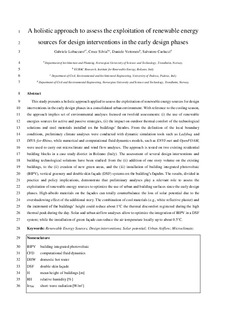| dc.contributor.author | Lobaccaro, Gabriele | |
| dc.contributor.author | Croce, Silvia | |
| dc.contributor.author | Daniele, Vettorato | |
| dc.contributor.author | Carlucci, Salvatore | |
| dc.date.accessioned | 2018-08-15T12:09:23Z | |
| dc.date.available | 2018-08-15T12:09:23Z | |
| dc.date.created | 2018-08-07T23:26:10Z | |
| dc.date.issued | 2018 | |
| dc.identifier.citation | Energy and Buildings. 2018, 175 235-256. | nb_NO |
| dc.identifier.issn | 0378-7788 | |
| dc.identifier.uri | http://hdl.handle.net/11250/2558151 | |
| dc.description.abstract | This study presents a holistic approach applied to assess the exploitation of renewable energy sources for design interventions in the early design phases in a consolidated urban environment. Concerning the cooling season, the approach implies set of environmental analyses focused on twofold assessments: (i) the use of renewable energy sources for active and passive strategies, (ii) the impact on outdoor thermal comfort of the technological solutions and cool materials installed on the buildings’ facades. From the definition of the local boundary conditions, preliminary climate analyses were conducted with dynamic simulation tools such as Ladybug and DIVA-for-Rhino , while numerical and computational fluid dynamic models, such as ENVI-met and OpenFOAM , were used to carry out microclimate and wind flow analyses. The approach is tested on two existing residential building blocks in a case study district in Bolzano (Italy). The assessment of several design interventions and building technological solutions have been studied: from the (i) addition of one-story volume on the existing buildings, to the (ii) creation of new green areas, and the (iii) installation of building integrated photovoltaic (BIPV), vertical greenery and double skin façade (DSF) systems on the building’s façades. The results, divided into practice and policy implications, demonstrate that preliminary analyses play a relevant role to assess the exploitation of re- newable energy sources to optimize the use of urban and building surfaces since the early design phases. High-albedo materials on the façades can counterbalance the loss of solar potential due to the over- shadowing effect of the additional story. The combination of cool materials (e.g., white reflective plaster) and the increment of the buildings’ height could reduce by about 1 °C the thermal discomfort registered during the high thermal peak during the day. Solar and urban airflow analyses allow optimizing the in- tegration of BIPV in a DSF system; while the installation of green façade can reduce the air temperature locally by up to about 0.5 °C. | nb_NO |
| dc.language.iso | eng | nb_NO |
| dc.publisher | Elsevier | nb_NO |
| dc.rights | Attribution-NonCommercial-NoDerivatives 4.0 Internasjonal | * |
| dc.rights.uri | http://creativecommons.org/licenses/by-nc-nd/4.0/deed.no | * |
| dc.title | A holistic approach to assess the exploitation of renewable energy sources for design interventions in the early design phases | nb_NO |
| dc.type | Journal article | nb_NO |
| dc.type | Peer reviewed | nb_NO |
| dc.description.version | acceptedVersion | nb_NO |
| dc.source.pagenumber | 235-256 | nb_NO |
| dc.source.volume | 175 | nb_NO |
| dc.source.journal | Energy and Buildings | nb_NO |
| dc.identifier.doi | https://doi.org/10.1016/j.enbuild.2018.06.066 | |
| dc.identifier.cristin | 1600287 | |
| dc.description.localcode | © 2018. This is the authors’ accepted and refereed manuscript to the article. Locked until 9.7.2020 due to copyright restrictions. This manuscript version is made available under the CC-BY-NC-ND 4.0 license http://creativecommons.org/licenses/by-nc-nd/4.0/ | nb_NO |
| cristin.unitcode | 194,61,55,0 | |
| cristin.unitcode | 194,64,91,0 | |
| cristin.unitname | Institutt for arkitektur og teknologi | |
| cristin.unitname | Institutt for bygg- og miljøteknikk | |
| cristin.ispublished | true | |
| cristin.fulltext | preprint | |
| cristin.qualitycode | 2 | |

